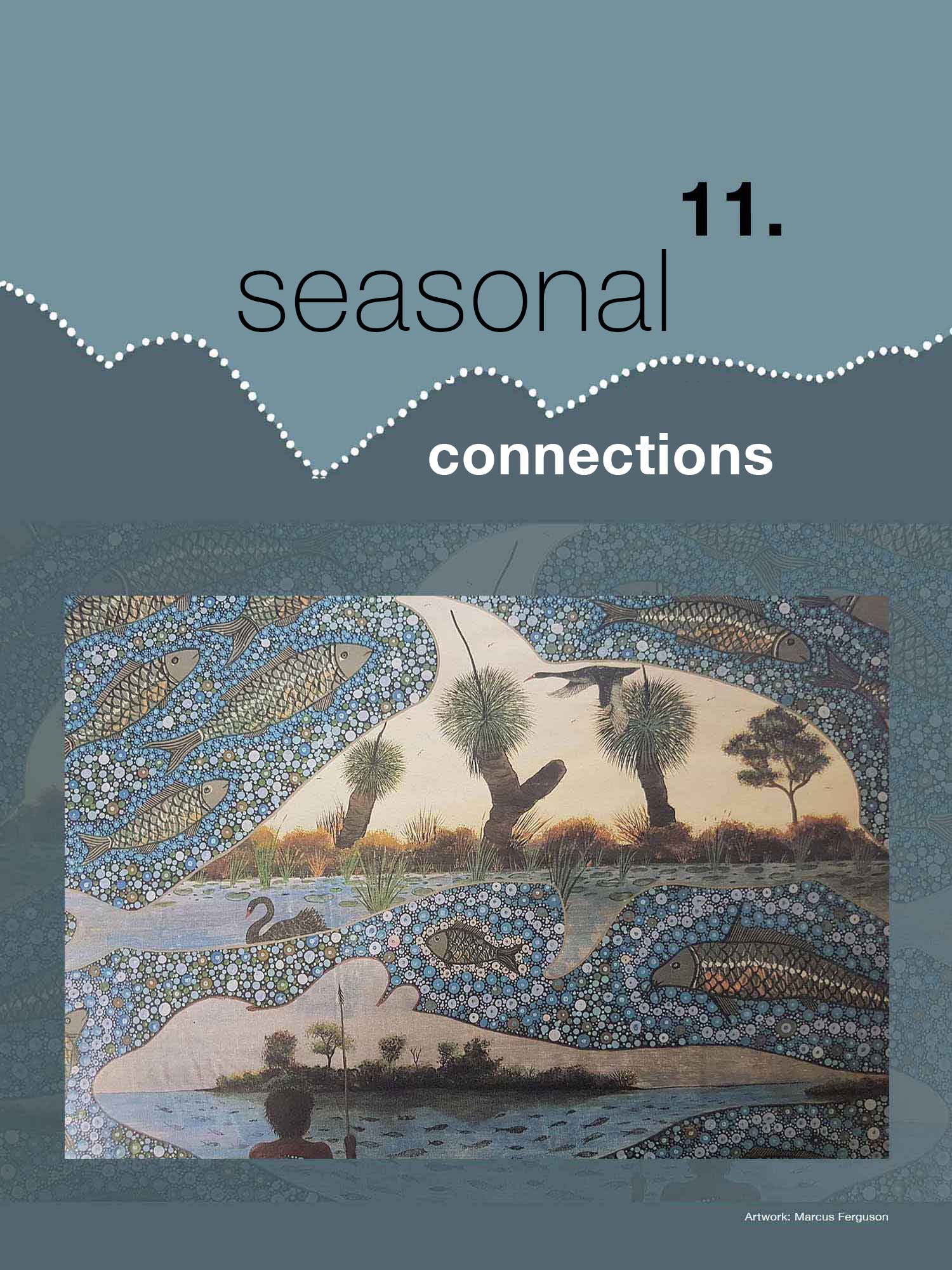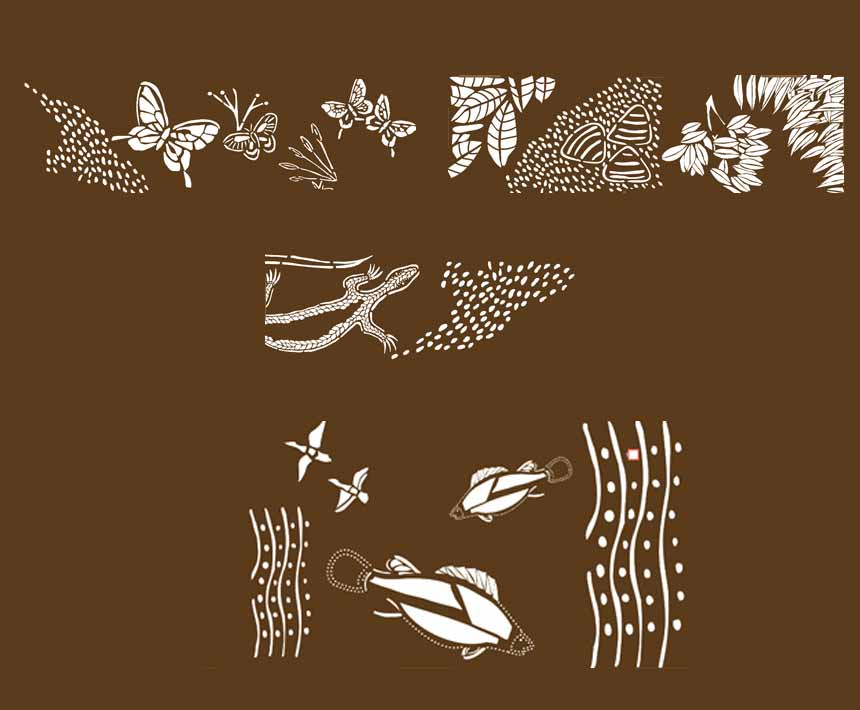The title of this artwork is "guuri-mii" - Sea Mullet Season. Artist Marcus Ferguson describes it as reminding him of the mullet season when the mullet come in from the ocean around May, June, July to spawn. There are always two dolphins following behind.

Along the Coastal Walk ...
Local Aboriginal culture recognises the interconnection between animals, plants and people. A healthy environment and healthy country are intertwined with healthy people and culture. Included here is information about important seasonal signs for gathering food. Today we can see evidence of bush tucker plants and native resource plants along the Coastal Walk thanks to the success of bush regeneration projects undertaken here.
Oyster gathering
Newspaper extract from the Richmond River Herald, 6 October 1922
 "The hunting ground of the Ballina tribes extended north to Broken Head and back from the beaches to the Big Scrub.
The seasons were known to them by foliage and flowers, and the great book of nature undoubtedly revealed to them many of its secrets.
They could tell by natural signs of flowers and fruits when the salmon and the mullet were due on the beaches and in the rivers, and also when certain game was bound to be in evidence in particular localities.
The tribe usually camped in divisions at different places excepting during the oyster season, when they assembled unitedly at Chickiaba, on North Creek, where the large oyster banks on the foreshores to this day mark the old feeding grounds.
Naturally conversant with the ways of the bush and the scrubs, they were of incalculable assistance to the cedar getters.
They also became fine axemen and expert at squaring the logs, rafting, and bullock driving."
"The hunting ground of the Ballina tribes extended north to Broken Head and back from the beaches to the Big Scrub.
The seasons were known to them by foliage and flowers, and the great book of nature undoubtedly revealed to them many of its secrets.
They could tell by natural signs of flowers and fruits when the salmon and the mullet were due on the beaches and in the rivers, and also when certain game was bound to be in evidence in particular localities.
The tribe usually camped in divisions at different places excepting during the oyster season, when they assembled unitedly at Chickiaba, on North Creek, where the large oyster banks on the foreshores to this day mark the old feeding grounds.
Naturally conversant with the ways of the bush and the scrubs, they were of incalculable assistance to the cedar getters.
They also became fine axemen and expert at squaring the logs, rafting, and bullock driving."
Salmon hunting
Newspaper extract from the Richmond River Herald, 6 October 1922

"In the month of September each year, the blacks [sic] flocked to the beaches for salmon fishing. This was a very fine eating fish, resembling a small jewy in shape, and while the brief season of a month lasted Binghi's larder was full to overflowing. They came in huge shoals inside the surf, where the blacks [sic] could spear them in any number; then they would disappear from the coast as suddenly as they came."
Pigface (Carpobrotus glaucescens)

Keep your eyes out for the beautiful pink flowers of the Pigface that contains the delicious salt strawberry.
You can forage for the fruits between October and February. Pigface and other native ingredients and bush foods are becoming more and more recognised for their high vitamin content and health benefits, promoted in television programs, such as MasterChef and featuring on the menus of restaurants and cafes in Lennox Head, Ballina and the northern NSW.
Lois Cook explains that:
“The juice from the leaves has been used as a universal first aid, for jellyfish stings, wounds, insect bites, and astringent, ... it behaves similar to aloe vera when applied to the skin for sunburns and various skin complaints, cold sores, cracked lips and chaffing skin conditions."
The Pigface plant fruits between October and February. Pigface and other native ingredients and bush foods are becoming more and more recognised for their high vitamin content and health benefits, promoted in television programs, such as MasterChef and featuring on the menus of restaurants and cafes in Lennox Head, Ballina and the northern NSW.
Pandanus (Pandanus pedunculatus)

Pandanus is an iconic coastal tree with a distinctive clumping growth habit. It is often found close to the shoreline and on the lee of headlands where, if protected from prevailing winds, can grow up to 10m in height.
It is a favoured and very useful species for Aboriginal people and is found along the east coast of Australia north from Port Macquarie.
Also known as the Screw Pine or Screw Palm, Pandanus leaves are tough, forming dense crowns of hanging ‘straps’ fringed with hooked margins. Stripped leaves were used for coiled baskets and fronds were used for folded baskets.
A gargle to treat sores in the mouth can be made from the juice obtained by pounding the inner core of the growing tip.
Fruits are large basketball sized and are segmented into between 40 and 200 wedge like phalanges, with an outer fibrous husk.
The base of phalanges could be chewed for a sweet pulp, after first being prepared by washing, and up to eight internal seeds were extracted, roasted and eaten.
When ripe the fruits turn orange and separate before falling to the ground. The phalanges (segments) float and can travel vast distances on ocean currents. There are numerous sub-species around the Pacific and the fruits are popular in traditional diets.
There are also records (from northern Australia) that Pandanus were propagated by Aboriginal people and ripe fruits were fermented, producing a brewed drink. Research information, Ian Fox & Associates
Coastal Cypress (Callitris columellaris))

Coastal Cyprus is an important part of Australia’s Indigenous culture and it is known that remaining stands of old growth trees are culturally significant and often also contain sites of cultural value.
Resin is used to make glue while the cones, bark, leaves and ash are used in various medicines. Coastal Cyprus bark is used to make rope and the smoke from burning the timber on campfires repels mosquitoes and other biting insects.
Burning timber of Coastal Cyprus had a pungent and distinctive smell that was characteristic in the area around traditional Aboriginal campsites, leading to a conclusion that despite being very fire intolerant, Coastal Cyprus Forests were valued and managed to ensure their abundance at favoured coastal camping locations.
Only small areas of the original distribution of Coastal Cyprus Pine Forest remain. Distribution is generally on sandy soils, within 30km of the coast, and between Angourie in the south to the Logan River in South-east Queensland.
Coastal Cyprus are fire sensitive and generally killed when burnt, especially with inappropriate fire regimes. Undisturbed stands of the community have a woodland or forest structure and as a community have significant conservation value. Source: Office of Environment and Heritage – Coastal Cyprus Pine in the NSW North Coast Bioregion (DECC 2009/167)
Paperbark (Melaleuca quinquenervia)

Paperbark are a common tree species around coastal swamps and lake margins of eastern Australia.
They grow 10-15m high and are easily recognised by the pale and thin strips of papery bark which cover the trunk and branches.
The leaves contain numerous glands which give an aromatic oil when crushed. Flower spikes are pale and creamy, typically ‘bottlebrush’ in appearance. They appear in autumn and winter, producing clusters of woody fruits with many tiny seeds arranged along the branchlets during and after flowering.
Paperbark has many cultural uses.
The bark peels off in strips and can be used for wrapping food for cooking, for making bandages, for disposable raincoats, for lining containers, and for mending holes in canoes. Sheets of bark can also be used as padding for bedding and for waterproofing small shelters or Mia Mia (huts).
A liquid made from the leaves can be used as a wash and the leaves can also be boiled to make a pleasant tea. Nectar rich blossoms can be soaked in water to make a sweet drink.
All the Melaleuca species can be used to treat symptoms of colds, flu and sinusitis by inhaling the steam from boiling or burning the leaves. Young leaves can also be crushed in the hands and the released oils inhaled deeply to relieve headaches, blocked sinuses, coughs and runny noses. Research information, Ian Fox & Associates

Cutout panel artwork credits

Metal panel artwork credits: Bunjum Saltwater Women Art Group, Oral Roberts.

